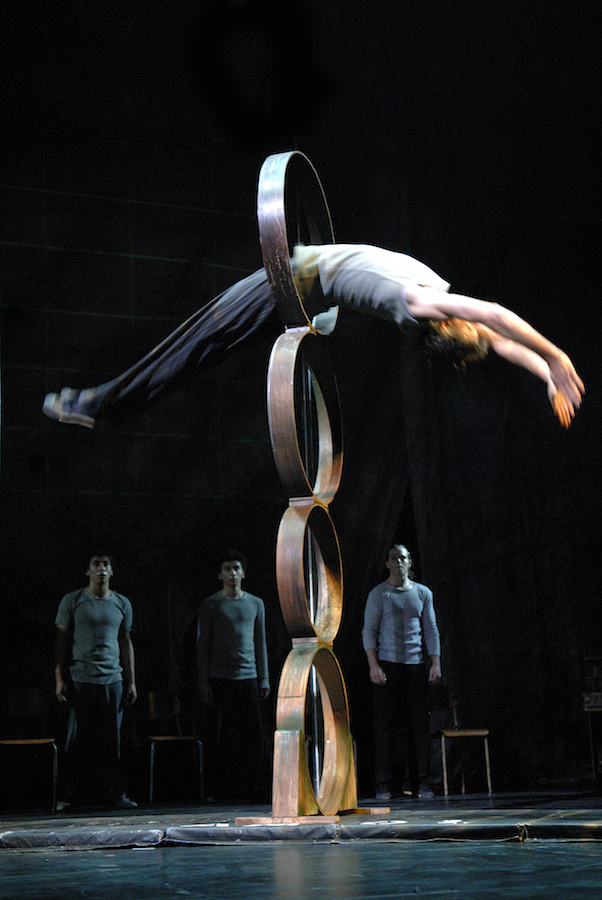Assembly Hall, Edinburgh Festival Fringe; 7th August 2015

Traces is – in the UK at least – the 7 Fingers’ signature show since the finale sequence of Chinese hoop diving appeared on the Royal Variety Performance in 2009, with two hit runs in London. It suggests that we are each a palimpsest, made and inherently influenced by the traces of those who have come before us, and those whose lives intersect ours.
The vintage and the bang-up-to-date collide and fuse throughout this 60 minute version of the show (this is Edinburgh Fringe, one hour is the standard length for all shows – although there are the odd exceptions in unique venues).
As we enter the theatre, we watch others doing the same via live feed CCTV from the hall’s entrance, projected onto the mildewed looking curtain that frames the tatty and tired chairs and old driftwood piano onstage. The real time clock is a relevant reminder of the here and now, while the speakeasy jazz instrumental keeps us connected to the past.
Above all, these connections are kept urban; even the lights on stage are repurposed xenon streetlamps. That may mean an acrobatic dance interpretation of a car crash scene, an ensemble skateboarding choreography, or Kevin Beverley as the survivor of a Hiroshima-like disaster, whipping aerial chains around his body under strobe lighting, living for today. Live feed video is used again as Song Enmeng hunches over a metal desk, drawing chinese symbols that become city skyscrapers, later to be swept away by giant waves.
The members of the company are all introduced to us, through autobiographical speech and digitally projected vital statistics. Personalities mostly remain hidden behind activity, with an undercurrent of street smart toughness, a frisson of competition, running through the whole show. During Anne-Marie Godin and Harley McLeish‘s hand-to-hand adagio, the seeming distrust of their performed relationship contrasts intriguingly with the implicit trust inherent to such an act.
Traces does have humour too – it’s less sophisticated than the choreographic elements, but it manages to prevent the show from darkening too far. Godin presents a nice routine with a chintz armchair and a book that’s warmly recognisable. Musical choices are, as when I saw Séquènce 8, from the public canon but unusual and well chosen.
Yann LeBlank moves from spinning on the wheels of his skates to spinning inside a Cyr in an atmosphere of holler and beer bottles and Irish-American country rock. Beverley plays on the word ‘time’ into the microphone. Enmeng melds tricking skills, a dancer’s rhythmic sensibilities, with flawless and varied diabolo tosses and manipulations, expertly building the drama up to the final trick of juggling three into the air from his one string. A series of baby photos show the company at different ages and Godin, in a coming of age dress, is taken for a spin on the aerial straps, counterweighted by Lucas Boutin at the side of the stage. (Special mention also for Boutin’s single handed hopping ascent around the Chinese pole earlier in the show).
The excellence of the hoop diving, introduced in a frenzy of sirens and flashing lights, is no surprise. The routine feels like a new circus classic, and I get the same thrill from watching a moment of artistic history as I did from watching Sir Ian McKellen and Sir Patrick Stewart play together onstage in Waiting For Godot a few years back.
Finally, now only visible on the CCTV, the company are rewarded with a rapturous applause that they can’t even hear. Actually, they probably can. We’re pretty loud.
.




